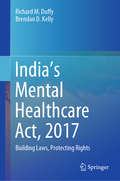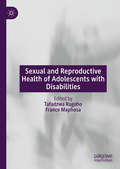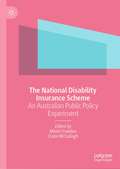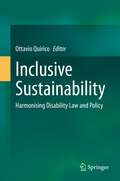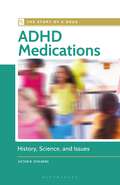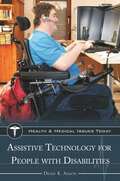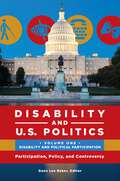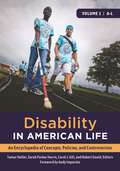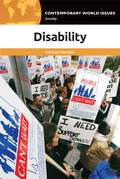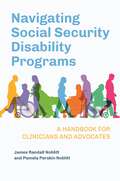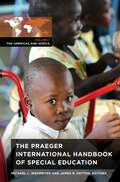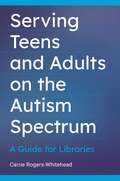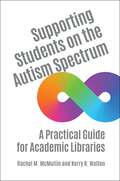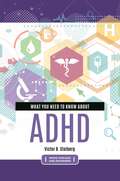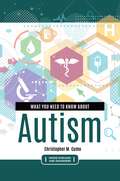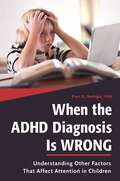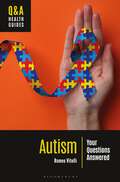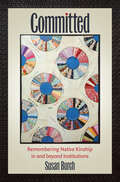- Table View
- List View
India’s Mental Healthcare Act, 2017: Building Laws, Protecting Rights
by Richard M. Duffy Brendan D. KellyThis book comprehensively discusses the background to the passing of India's revolutionary Mental Healthcare Act, 2017, offering a detailed description of the Act itself and a rigorous analysis in the context of the CRPD and the World Health Organization (WHO) standards for mental health law. It examines the fine balance, between complying with the CRPD while still delivering practical, humane, and implementable legislation. It explores how this legislation was shaped by the WHO standards and provides insights into areas where the Indian legislators deviated from these guidelines and why. Taking India as an example, it highlights what is possible in other low- and middle-income countries. Further it covers key issues in mental health, identifying potential competing interests and exploring the difficulties and limitations of international guidelines.The book is a valuable resource for psychiatrists, nurses, social workers, non-governmental organizations and all mental healthcare workers in India and anyone studying human rights law.
Sexual and Reproductive Health of Adolescents with Disabilities
by Tafadzwa Rugoho France MaphosaThis book investigates various experiences of teaching sexual and reproductive health to adolescents with disabilities. Following the adoption of the UNCRPD, adolescents with disabilities still commonly suffer from widespread violation of their rights particularly concerning sexual and reproductive health – often being viewed as either asexual or hypersexual. Contemporary societies do not readily encourage the participation of these young people in conversations or decision making processes concerning their own sexual and reproductive health. This book delves into such complex issues, critically examining how global communities attempt to teach sexual and reproductive issues to adolescents with disabilities in the modern era.
The National Disability Insurance Scheme: An Australian Public Policy Experiment
by Mhairi Cowden Claire McCullaghThe National Disability Insurance Scheme (known commonly as the NDIS) was introduced as a radical new way of funding disability services in Australia. It is a rare moment in politics and policy making that an idea as revolutionary, ambitious and expensive as the NDIS makes it into its implementation phase. Not surprising, then, that the NDIS has been described by many as the biggest social shift in Australia since Medicare. This book will be a key text for scholars and public policy professionals wishing to understand the NDIS, how it was designed, and lessons learned through its introduction and roll-out. The book addresses how the NDIS has intersected with particular cohorts and sectors, and some of the challenges that have arisen. It highlights the experiences of people with disability through a collection of personal stories from participants and families in the NDIS. The key insights from this large scale public policy experiment are relevant for anyone interested in social change in Australia, or internationally.
Inclusive Sustainability: Harmonising Disability Law and Policy
by Ottavio QuiricoIn light of the third-generation concept of ‘inclusive sustainability’, the volume explores the architecture of global disability governance and its degree of harmonisation. The book integrates socio-cultural, economic, political and legal analyses from an international and comparative perspective. The first part of the volume outlines a tripartite systematisation of disability rights for States and non-state persons. In light of essential economic considerations, the second part explores the relationship between disability and specific fundamental rights and regimes, particularly the rights to life, health, education, work and participation. The third part takes an institutional approach and focuses on the way in which the UN and regional organisations regulate disability (rectius, different ability).
ADHD Medications: History, Science, and Issues (The Story of a Drug)
by Victor B. StolbergThe treatment of attention deficit/hyperactivity disorder (ADHD) is a complex challenge. This book provides comprehensive, scientific coverage of the numerous different types of drugs that are used to treat ADHD, and it examines the historical, sociological, and policy-related factors involved in the use of ADHD medications.A national study indicated that 11 percent of U.S. children and teens were diagnosed with attention deficit/hyperactivity disorder (ADHD) in 2011—a figure 43 percent higher than in 2003. The incidence of ADHD diagnoses among females has also increased significantly. For the millions of Americans of all ages who are diagnosed with ADHD, the proper treatment of this disorder is critically important. ADHD Medications: History, Science, and Issues provides readers with the complete story of ADHD drugs. The book discusses the pharmacological basis of the effects of these powerful drugs; examines the myriad social dimensions of the use, misuse, and abuse of these substances; and identifies the range of issues that affect the recognition, diagnosis, and treatment of ADHD.After an introductory case study of an individual with ADHD and this individual's problems and successes with ADHD medicines, this new book in the Story of a Drug series provides an overview of ADHD and its various symptoms, as well as the causes, prevalence, and diagnosis of ADHD. Various treatment approaches—including information about the many medications used—are discussed in detail, as well as other substances and alternative ways used to treat individuals with ADHD. Readers will also gain an understanding of neurotransmission and the specific mechanism of action of ADHD medications; the effects and applications of these drugs, plus their associated risks, misuse, and abuse; as well as related policy issues, with special focus on the controversial issues regarding ADHD drug scheduling (categorization).
Assistive Technology for People with Disabilities (Health and Medical Issues Today)
by Denis K. AnsonHow would you make a phone call or send email if you couldn't hear, see, or use your hands? This book shows how assistive technology helps individuals with disabilities perform tasks that people without disabilities may take for granted.Assistive technology can be used in two ways: to help people with disabilities to do things that people without disabilities can do without technology, and to improve access to everyday technology that is not designed for people with disabilities. In both cases, the focus is on matching individuals with the tools best suited to fill their needs. A part of Greenwood's Health and Medical Issues Today series, Assistive Technology for People with Disabilities explores what technologies are available to individuals with disabilities, what they can help them to accomplish, and potential hurdles to their use that must be overcome. It explores this exciting field broadly and in depth while still keeping the "people-first" mindset that is the hallmark of assistive technology. In addition, it provides guidance and resources for individuals seeking assistive technology for themselves or for a loved one.
Disability and U.S. Politics [2 volumes]: Participation, Policy, and Controversy [2 volumes]
by Dana Lee BakerMore than 1 billion people worldwide have a disability, and they are all affected by politics. This two-volume work explores key topics at the heart of disability policy, such as voting, race, gender, age, health care, social security, transportation, abuse, and the environment.Disability policy is no longer an area that can be adequately addressed within major areas of public policy such as welfare, health, labor, and education. Disability has become widely acknowledged in recent decades, partly because of the increasing number of disabled citizens across all demographic populations. Advocates argue that diversity of all kinds deserves recognition and accommodation. This set examines policies targeting disability to provide a multifaceted description of the political participation of people with disabilities as well as disability policy development in the United States. The first volume focuses on political participation and voting issues, and the second volume covers disability public policy.In these two volumes, numerous scholars and experts in the social sciences and humanities explore timely topics that are key to disability policy questions, including activism, voting, race, gender, age, health care, social security, civil rights, abuse, the environment, and even death. Readers will better understand the challenges that policymakers face in grappling with controversies over issues of social engineering and public policy, often attempting to reconcile majority experience with minority rights. The chapters analyze the history of disability politics, describe the disability policy infrastructure as it currently exists in the United States, and provide insight into current disability-related controversies.
Disability in American Life [2 volumes]: An Encyclopedia of Concepts, Policies, and Controversies [2 volumes]
by Tamar Heller, Sarah Parker Harris, Carol J. Gill, and Robert GouldDisability—as with other marginalized topics in social policy—is at risk for exclusion from social debate. This multivolume reference work provides an overview of challenges and opportunities for people with disabilities and their families at all stages of life.Once primarily thought of as a medical issue, disability is now more widely recognized as a critical issue of identity, personhood, and social justice. By discussing challenges confronting people with disabilities and their families and by collecting numerous accounts of disability experiences, this volume firmly situates disability within broader social movements, policy, and areas of marginalization, providing a critical examination into the lived experiences of people with disabilities and how disability can affect identity.A foundational introduction to disability for a wide audience—from those intimately connected with a person with a disability to those interested in the science behind disability—this collection covers all aspects of disability critical to understanding disability in the United States. Topics covered include characteristics of disability; disability concepts, models, and theories; important historical developments and milestones for people with disabilities; prominent individuals, organizations, and agencies; notable policies and services; and intersections of disability policy with other policy.
Disability: A Reference Handbook (Contemporary World Issues)
by Michael RembisThis volume offers a rare mix of interpretive chapters and primary sources that will be of value to anyone interested in learning about important disability-related issues and exploring the perspectives of disabled people.Disability has become a human rights and social justice issue that should concern all Americans. Access to safe, affordable, and effective health care, access to safe and affordable housing, access to reliable and efficient public transportation, and the ability to work and participate freely in the community are central to disability justice movements. Unlike encyclopedias or biographical dictionaries that only offer brief accounts of key topics, people, events, and organizations, Disability: A Reference Handbook provides important interpretive and analytical frameworks and meaningful primary evidence. The book opens with a chapter dedicated to the history of disability in the United States, placing 21st-century issues and concerns within their contexts. The next chapter explores important controversies and questions related to disability. The third chapter brings diverse voices to the topic, and the fourth chapter offers valuable profiles of key people and organizations. The remaining chapters provide valuable reference tools that will help readers to explore topics in more depth and to engage in independent research.
Navigating Social Security Disability Programs: A Handbook for Clinicians and Advocates
by James Randall Noblitt Pamela Perskin NoblittThis book responds to a previously unmet need: unlocking the mysteries of Social Security disability programs and providing medical and mental health clinicians, as well as advocates, with the information necessary to act in the best interests of their clients.This text aims to bring clarity to medical and psychological health care providers so they better understand the importance of their role in disability determinations by familiarizing them with the benefits, limitations, and qualifications for Social Security Disability Insurance and Supplemental Security Income. Also useful for patient advocates, the authors here provide insights into the workings of Social Security, the language employed, the definitions adhered to, and the reliance on providers to respond to requests from Social Security and their patients to support their claims when warranted. Almost all medical and mental health professionals will need to interact with Social Security at some point, but will not understand the relevance or importance of their response. Much hangs on the clarity of treatment notes and opinions rendered by clinicians. Not only can their failure to respond to requests for Social Security, or to their patients in a disability case, obstruct their patients' access to benefits, it may also put a provider at risk of board censure or civil suit.
The Praeger International Handbook of Special Education [3 volumes]: [3 volumes]
by Michael L. Wehmeyer and James R. PattonThis handbook provides a concise overview of special education services in countries across the world, using the Article on Education in the United Nations Convention on the Rights of Persons with Disabilities as the analytical frame.The Praeger International Handbook of Special Education presents a concise and clear overview of special education services in more than 70 countries across the world using the Article on Education in the United Nations Convention on the Rights of Persons with disabilities as the analytical frame. Each chapter offers information about the country in general, followed by sections on the public education system, the private education system, the special education system, teacher training requirements, and barriers to and promising trends in inclusive and special education. The volumes and chapters are organized by the United Nations Geoscheme, with Volume 1 including an overview of the volumes and chapters on countries in the Americas, Volume 2 addressing countries from Europe and Africa, and Volume 3 focusing on countries in Asia and Oceania. This is the most complete exploration of the delivery of supports and services to children and youth with disabilities across the globe available. The volumes do not compare among or between countries, but rather provide a baseline for understanding current special education practices and their relationship with general education and inclusive practices across the globe. Readers will come away with an in-depth understanding of what is happening with regard to the implementation of special education services and Article 24 of the Convention for the Rights of People with Disabilities. This valuable reference set serves researchers, graduate students, and policymakers in special and general education as well as professionals focused on issues of education worldwide and scholars focused on international special education. As such, this handbook will be an important reference source for university libraries, professional associations, and policy entities.
Serving Teens and Adults on the Autism Spectrum: A Guide for Libraries
by Carrie Rogers-WhiteheadUnderstand the unique needs of teens and adults with autism and how to adapt existing library programs to be more inclusive.Autism spectrum disorder is a lifelong condition, but programs and services are mostly for children. As this population ages and the number of adults receiving autism diagnoses grows, are public libraries serving this group? Serving Teens and Adults on the Autism Spectrum offers practical strategies for delivering better service to individuals with autism, from library programming to technology, collections, library volunteers, and the information desk. Relying on feedback and help from the autism community in her area, Carrie Rogers-Whitehead created programs for children, teens, and young adults on the autism spectrum. In this book, she shares advice on developing programs that focus on teamwork, transitions, and social skills. She explains best practices for reference interviews and teaches readers how their libraries can partner with nonprofit and government entities to develop workforce skills and connect adults with autism to jobs. Ready-made program activities for teens and adults with autism make it easy for libraries to better serve this often misunderstood group.
Supporting Students on the Autism Spectrum: A Practical Guide for Academic Libraries
by Rachel M. McMullin Kerry R. WaltonThis book will be invaluable for those in the academic library who want to understand how best to serve students on the autism spectrum and how those students can contribute to the library.As a large number of students on the autism spectrum come of age and enter college, increased awareness of autism spectrum disorder is necessary among those who work in academic libraries so that they can respond to and meet the unique needs of these students. This book fills a scholarship gap while serving as a practical resource for working with the neurodivergent student population in academic libraries. McMullin and Walton explain issues that are likely to arise when interacting with students on the autism spectrum and offer practical solutions for handling them. They discuss how to work with neurodiverse students in different contexts, including at service points, in the classroom, as employees, and through outreach programs. They highlight possible concerns about the physical environment of the library and demonstrate ways that the library can be an especially positive place for students with ASD. Personal anecdotes from students with autism as well as library faculty and staff round out this valuable work.
What You Need to Know about ADHD (Inside Diseases and Disorders)
by Victor B. StolbergThis book offers an accessibly written introduction to ADHD, focusing on the topics that matter most to readers. The information it provides makes it an indispensable resource for anyone whose life is affected—directly or indirectly—by this disorder.Attention deficit hyperactivity disorder (ADHD) is a neurodevelopmental disorder that may lead to difficulties paying attention, problems controlling behavior, and excessive activity. What You Need to Know about ADHD conveys what individuals and families affected by ADHD need to know about it in order to manage its symptoms and to help their loved ones to grow.This book is a part of Greenwood's Inside Diseases and Disorders series, which profiles a variety of physical and psychological conditions, distilling and consolidating vast collections of scientific knowledge into concise, readable volumes. A list of "Top 10" essential questions begins each book, providing quick-access answers to readers' most pressing concerns. The text follows a standardized, easily navigable structure, with each chapter exploring a particular facet of the topic. In addition to covering basics such as causes, signs and symptoms, diagnosis, and treatment options, books in this series delve into issues that are less commonly addressed but critical to understand, such as effects on loved ones and caregivers. Case illustrations highlight key themes discussed in the book and are accompanied by insightful analyses and recommendations.
What You Need to Know about Autism (Inside Diseases and Disorders)
by Christopher CumoThis book offers an accessibly written introduction to autism that make it an indispensable resource for anyone whose life has been affected—directly or indirectly—by this condition.Autism is a spectrum of developmental disorders that can range from mild to severe. Individuals with autism often have difficulties with communication, social interaction, and sensory processing, and may engage in repetitive or restricted behaviors. Beyond this definition, however, what finer points and real-life implications of these disorders do individuals and families affected by autism need to know?What You Need to Know about Autism is a part of Greenwood's Inside Diseases and Disorders series. This series profiles a variety of physical and psychological conditions, distilling and consolidating vast collections of scientific knowledge into concise, readable volumes. A list of "Top 10" essential questions begins each book, providing quick-access answers to readers' most pressing concerns. The text follows a standardized,easily navigable structure, with each chapter exploring a particular facet of the topic. In addition to covering basics such as causes, signs and symptoms, diagnosis, and treatment options, books in this series delve into issues that are less commonly addressed but still critical to understand, such as effects on loved ones and caregivers. Case illustrations highlight key themes discussed in the book and are accompanied by insightful analyses and recommendations.
When the ADHD Diagnosis Is Wrong: Understanding Other Factors That Affect Attention in Children
by Paul G. SwingleA game-changing resource for parents caught in the labyrinth of the promoted treatments heralding help for troubled children and their families, this book provides readers invaluable guidance in seeking accurate diagnosis and scientifically verified treatment options.Attention Deficit Hyperactivity Disorder (ADHD) in children is real and can be severely disabling. However, most causes of children's attention problems are unrelated to ADHD and are not resolvable by drugging the child. Treating symptoms is simply not adequate; a completely different approach to the diagnoses and treatment of attention problems in children is necessary. This book identifies the many neurological patterns associated with children's attention challenges, explains the many psychological and physical factors that can affect attention, and describes how to determine if your child needs not medication but other approaches—such as psychological guidance, diet changes, or simply time to develop past childhood—to solve the problem.Paul G. Swingle, PhD, RPsych, provides millions of parents who are desperate for scientifically sound information about how to help their children with conditions that are negatively impacting their learning, development, and happiness with a resource that is precise, definitive, and easy to read. Illustrated with examples from across his 30 years of practice, Swingle's book informs readers about the many factors that can affect children's attention and can often be treated with drugless approaches and therapy for success. Parents will understand how intolerance of what constitutes normal children's behavior and the failure to recognize the emotional challenges that many children have in our culture today constitute causative factors in the misdiagnosis of attention deficit disorders.
Autism: Your Questions Answered (Q&A Health Guides)
by Romeo VitelliResearch suggests that about 1% of the world's population is on the autism spectrum. Discover the answers to common questions about living with neurodiversity.Part of the Q&A Health Guides series, this book offers a broad introduction to autism spectrum disorder (ASD). The book's 47 questions cover what ASD is and its common characteristics, the biological and environmental factors that may lead to ASD, how autism is diagnosed and managed, and how those living with ASD can reach their full potential. Autism: Your Questions Answered addresses these and other topics in a way that both celebrates neurodiversity and acknowledges the many challenges that those with ASD face.Augmenting the main text, a collection of 5 case studies illustrate key concepts and issues through relatable stories and insightful recommendations. The common misconceptions section at the beginning of the volume dispels 5 long-standing and harmful myths about ASD, directing readers to additional information in the text. The glossary defines terms that may be unfamiliar to readers, while the directory of resources curates a list of the most useful books, websites, and other materials. Finally, whether they're looking for more information about this subject or any other health-related topic, readers can turn to the guide to health literacy section for practical tools and strategies for finding, evaluating, and using credible sources of health information both on and off the Internet.
Committed: Remembering Native Kinship in and beyond Institutions (Critical Indigeneities)
by Susan BurchBetween 1902 and 1934, the United States confined hundreds of adults and children from dozens of Native nations at the Canton Asylum for Insane Indians, a federal psychiatric hospital in South Dakota. But detention at the Indian Asylum, as families experienced it, was not the beginning or end of the story. For them, Canton Asylum was one of many places of imposed removal and confinement, including reservations, boarding schools, orphanages, and prison-hospitals. Despite the long reach of institutionalization for those forcibly held at the Asylum, the tenacity of relationships extended within and beyond institutional walls. In this accessible and innovative work, Susan Burch tells the story of the Indigenous people—families, communities, and nations, across generations to the present day—who have experienced the impact of this history. Drawing on oral history interviews, correspondence, material objects, and archival sources, Burch reframes the histories of institutionalized people and the places that held them. Committed expands the boundaries of Native American history, disability studies, and U.S. social and cultural history generally.
